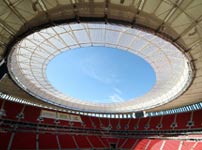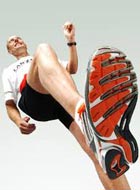When the 20th FIFA World Cuphas kicked off in Brazil early this June, the world is caught in frenzy. The month-long extravaganza being witnessed in Brazil has partly, if not totally, eclipsed the preparation pains the event had gone through.
Various new material technologies have been recoursed in preparing theseevent grounds. The soccer stadium, the EstadioNacional gets a functional treatment from materials firm BayerMaterialScience (BMS). These have been fitted with roofs made from sheets of transparent high performance plastics, that are ideal for use in tropical climate locations with high temperatures and heavy precipitation, like Brazil These transparent solid sheets, theMakrolon UV 2099 , has UV protection coating on both sides that survives years of weathering without damage. With a transparency of over 80%, the sheets simultaneously promote grass growth.
The team of architects from GMP (Architects von GerkanMarg and Partner) and Castro Mello Arquitetos have designed a beautifully shaped roof for the stadium. It is a circular suspension roof comprising double-walled structure held in place by a concrete ring. The final inner ring of the stadium roof in Brasilia consists of 110 metric tonnes of Makrolon sheets, with each sheet 12 mm thick and over 10 meters long. The sheets cover an estimated 7,500 sq m area.
Another architectural highlight is the "Arena das Dunas" (Stadium of the Dunes) in the coastal city of Natal. Here, the spaces in the roof structure are filled with 20 high, slim elements made of BMS's transparent polycarbonate of which none resembles another.

According to a press release by BMS, the polycarbonate material used not only in the stadiums in Brazil, but have also applied its strong, lightweight, flexible (can be shaped virtually at will), and colour-versatile functionalities in other similar venues, such as the shimmering, honey-coloured "Amber Arena" in Gdansk, Poland, built for the 2012 European Championship, and the "Spyridon Louis" Olympic stadium in Athens, Greece, which was the primary venue for the 2004 Summer Games .
Another BMS material utilised at this edition of World Cup are those raisedmarkings on the ground. Plastic sheets with tiny bumps will helpblind and visually impaired fans to find their way around the crowded soccer stadiums. BMS developed a material solution for the flooring based on the thermoplastic polyurethane (TPU) Desmopan DP 3059D.
The wayfinding system is already in use at other locations in the South American country such as banks, shopping centers and even subway stations. The system makes it easier for everyone, even people with normal vision, to find the right track more easily.
Winning gears
The stars of the football tournament are the powerhouse national football teams from 32 countries who are striking for the championship.
Sports brand Puma-sponsored players, such as Mario Balotelli, Marco Reus, and CescFábregas.get to wear the latest PUMA evoPOWER football boot, which is desgnedto optimise kicking power and accuracy. The hard-to-miss trick boots has a pink boot on the right foot and blue one on the left foot. Apart from the upper part of the two colours boots being made from a lightweight, stretchable material, integral to it is an elastomer called Pebax from French specialty Chemicals and Advanced materials company Arkema.
The outer sole plate of the boot is made of Pebax, which renders outstanding technical performances to the boots such as light weight, dynamic fit, and sturdiness. It delivers optimum responsiveness of the shoe to the player’s movements, while ensuring improved ball control as well as better adherence to the ground with its flexibility.
The evoPOWER also uses a foam made from Pebax in the Puma’s Accufoam technology for the padding of raised areas and the reinforcing strips on the shoe’s upper. This foam is three times lighter than the traditional ethylene-vinyl acetate (EVA) foam, for similar cushioning properties. These reinforcing strips provide both flexibility and comfort.
German specialty chemicals firm Lanxess also showcases its expertise in soccer shoes, which feature exchangeable or moulded studs of some kind underneath the soles to provide sufficient traction against slipping. The most common studs today are the exchangeable type, which can be inserted into the sole individually and are usually made of rubber or plastic. In the case of moulded studs, the rubber or plastic structures are part of the sole and cannot be removed. The sole must have at least 10 moulded studs. Artificial turf shoes feature numerous small studs. A number of different studs are available that are tailored to the type of playing field. Special LANXESS plastic and rubber products are used to fabricate them.

Martin Mezger, rubber product expert at Lanxess explains that the soles incorporate technology similar to that used in modern fuel-saving tyres. The Krynac is a silica technology that gives the tyres good grip and makes them particularly economical also ensures that running shoes have good grip, even on a wet track. This material is uniquely abrasion-resistant, durable, flexible and popular in this application, and thus benefit long distance runners additionally needing damping properties and elasticity. Midsoles made of modern high-performance rubber, such as Lanxess’sLevapren act as a buffer or cushion between the foot and the hard ground.
Incorporated in the soles of modern soccer shoes are high-performance plastics from the High Performance Materials business unit, such as Tepes, which reinforces the sole, yet is very lightweight. Ethylene-vinyl acetate rubber (EVM) has a cushioning and stabilising effect. During the manufacturing process, the synthetic rubber is first mixed with fillers, crosslinkers and foaming agents, after which it is kneaded and rolled before finally being foamed on exposure to heat.

Meanwhile, the official match ball of the World Cup is one from FIFA (FédérationInternationale de Football Association) partner, the German sports brand Adidas, Called Brazuca, it is the result of development collaboration between Adidas and BMS. The two companies have been working together in the field of ball development since 1986. From the outset, BMS’s polyurethane materials have played a key role. It is these products that give the high-tech balls their perfect shape and outstanding properties.
The Brazuca reveals its true qualities on the pitch - when precision passes are made or the ball flies true when shot towards the goal, regardless of outdoor conditions. More than 600 professional players and 30 teams in 10 countries tested the Brazuca under all kinds of outdoor conditions. The ball has also been used in friendly matches involving the German national team.
According to a statement from BMS, it’s the skin that turns the soccer ball into a piece of high-tech sports equipment. As for the ball’s structure, inside consists of an air-filled latex bladder. This is covered with a textile fabric that serves as a substrate for the outer layers. BMS said the outer skin comprises a total of five layers based on Impranil polyurethane raw materials, to ensure optimal ball contact and prevent any moisture absorption. They are also responsible for the fact that the shape and appearance of the ball are retained for a long period of time.
The innermost layer of the skin is an adhesion coating that connects the textile substrate to the layers above. On top of this is a polyurethane foam layer, roughly 1mm thick, made up of millions of gas-filled microspheres. This foam is highly elastic so that the ball, after being deformed from being kicked, immediately returns to its spherical shape to ensure an optimal trajectory.
The outer skin comprises three compact layers of polyurethane with different thicknesses. These layers are responsible for the outstanding resistance to external influences and abrasion, and for the ball’s high elasticity. They also help to preserve its unique appearance.
While the surface of conventional soccer balls consists of 12, 16 or even 32 panels, Brazuca is made up of only six panels of absolutely identical shape. This proves to be an advantage since the more panels used to cover the surface, the more seams there are that could absorb moisture. Also, fewer elements mean that the ball is more durable and more resistant to the elements.
The panels are bonded together using patented thermobonding technology. The manufacturers obtain optimal results under defined pressure and temperature conditions - and with a special, heat-activated adhesive based on BMS’s Dispercoll U raw materials.
(PRA)



















